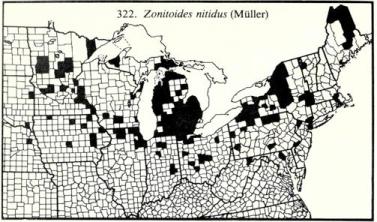
Habitat
Zonitoides nitidus is characterized as a terrestrial land snail. Z. nitidus is generally found in an environment near water or in swamp like places (Pilsbry, 1964). It is very rare to find Z. nitidus in the upland woods where the vegetation is dry. The black gloss snail, Z. nitidus, is a characteristic wetland species and is often seen in base-rich soil (Jordaens, 2003). This snail is often found living on low ground, under and in decaying logs. Z. nitidus can be found under forest debris and are abundant on the floodplains of streams, where they are often found scattered (Baker, 1939). When winter nears, Z. nitidus can congregate in great numbers under wet, dead logs, where they have began to prepare for hibernation (Pilsbry, 1964). This type of terrestrial snail requires a large amount of calcium to produce their calcareous shells, so they tend to choose their habitat based on the available calcium carbonate in that environment (Kalisz, 2003).
 Holarctic
species are characterized by their preference for cooler latitudes (Hubricht, 1985).
Z. nitidus is considered a holarctic species and can be found widely
distributed in the northern continents such as North America,
Europe, and Asia (Baker, 1939). In the United States, the spread of
this species is mainly in the North, and near the border of Canada
(Pilsbry,
1946). Specifically, the population of Z. nitidus is concentrated on the upper part of Illinois, Western
part of Wisconsin and Southern Michigan
(Baker, 1939). The map on
this page is of the Midwest, and North Eastern United States. The
distribution of Z. nitidus
can be seen on this map, which was published in 1985
(Hubricht,
1985).
Holarctic
species are characterized by their preference for cooler latitudes (Hubricht, 1985).
Z. nitidus is considered a holarctic species and can be found widely
distributed in the northern continents such as North America,
Europe, and Asia (Baker, 1939). In the United States, the spread of
this species is mainly in the North, and near the border of Canada
(Pilsbry,
1946). Specifically, the population of Z. nitidus is concentrated on the upper part of Illinois, Western
part of Wisconsin and Southern Michigan
(Baker, 1939). The map on
this page is of the Midwest, and North Eastern United States. The
distribution of Z. nitidus
can be seen on this map, which was published in 1985
(Hubricht,
1985).
The water and calcium carbonate rich environment that Z. nitidus prefers can cause trouble for the terrestrial snail. Other organisms such as lizards, turbellarian worms, scorpions, insects and other terrestrial snails, which are predators of Z. nitidus, also prefer base-rich soils (Chase, 2002).
How has Zonitoides nitidus
adapted to its surroundings?
Home